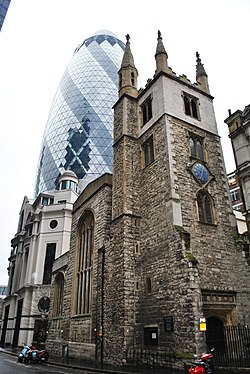St Andrew Undershaft
| St Andrew Undershaft | |
|
London, Middlesex | |
|---|---|
 St Andrew Undershaft in 2013 | |
| Church of England | |
| Diocese of London | |
| Location | |
| Location: | 51°30’49"N, 0°4’53"W |
| Address: | St Mary Axe |
| History | |
| Built 1532 | |
| Perpendicular style | |
| Information | |
St Andrew Undershaft is a Church of England church in the City of London, Middlesex. It stands on St Mary Axe, within the Aldgate ward, and is a rare example of a City church that survived both the Great Fire of London and the Blitz.[1]
The present building was constructed in 1532 but a church has existed on the site since the 12th century. Today, St Andrew Undershaft is administered from the nearby St Helen's Church, Bishopsgate.
St Andrew Undershaft is designated a Grade I listed building.[2]
History

The first church on the site, which today is bordered by St Mary Axe and Leadenhall Street, was built in the Middle Ages, being recorded in 1147.[3] It was rebuilt in the 14th century and again in 1532;[4] this third incarnation of the building survives today. It is in the Perpendicular style[5] with its entrance located at the base of its off-centre tower. The interior is divided into six bays, with many of the original fittings that survived Victorian renovation. Formerly, St Andrew Undershaft had one of London's few surviving large stained-glass windows, installed in the 17th century, but this was destroyed in the Baltic Exchange bombing in 1992.
The church's curious name derives from the shaft of the maypole[6] that was traditionally set up each year opposite the church.[7] The custom continued each spring until 1517, when student riots put an end to it, but the maypole itself survived until 1547 when it was seized by a mob and destroyed as a "pagan idol".
St Andrew Undershaft is now administered from the nearby church of St Helen's Bishopsgate.

Music
The tower holds a peal of six bells in the key of G, with the tenor being cast in 1597 by Robert Mot. These are now hung dead (they can only be rung stationary) inside the tower.[8]
The organ was installed in 1696 by Renatus Harris. A swell was added in 1750 by John Byfield. There have been other restorations and enhancements by George Pike England in 1810–11 and 1826. Further work was carried out by William Hill, Speechly and J. W. Walker & Sons, and Rushworth and Dreaper. A specification of the organ can be found on the National Pipe Organ Register[9]
The organ is of such historic significance that it has been awarded a Grade I historic organ certificate by the British Institute of Organ Studies.
Outside links
| ("Wikimedia Commons" has material about St Andrew Undershaft) |
References
- ↑ The Visitors Guide to the City of London Churches Tucker, T: London, Friends of the City Churches, 2006 ISBN 0-9553945-0-3
- ↑ National Heritage List 1079155: St Andrew Undershaft
- ↑ The London Encyclopaedia Hibbert, C.; Weinreb, D.; Keay, J.: London, Pan Macmillan, 1983 (rev 1993, 2008) ISBN 978-1-4050-4924-5
- ↑ London:the City Churches Pevsner, N./Bradley, S.: New Haven, Yale, 1998 ISBN 0-300-09655-0
- ↑ Betjeman, J.: 'The City of London Churches' (Pikin, 1967) ISBN 0-85372-112-2
- ↑ The City Churches Tabor, M. p. 27:London; The Swarthmore Press Ltd; 1917
- ↑ Cobb, G. London city churches: London, B T Batsford Ltd., 1977
- ↑ http://london.lovesguide.com/andrew_undershaft.htm
- ↑ National Pipe Organ Register website.